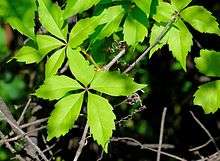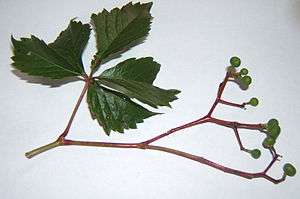Parthenocissus vitacea
| Parthenocissus vitacea | |
|---|---|
 | |
| Scientific classification | |
| Kingdom: | Plantae |
| (unranked): | Angiosperms |
| (unranked): | Eudicots |
| (unranked): | Rosids |
| Order: | Vitales |
| Family: | Vitaceae |
| Genus: | Parthenocissus |
| Species: | P. vitacea |
| Binomial name | |
| Parthenocissus vitacea (Knerr) Hitchc. | |
| Synonyms | |
|
P. inserta (Kern.) | |
Parthenocissus vitacea (syn. P. inserta), also known as thicket creeper, false Virginia creeper, woodbine, or grape woodbine, is a woody vine native to North America, in southeastern Canada (west to southern Manitoba) and a large area of the United States, from Maine west to Montana and south to New Jersey and Missouri in the east, and Texas to Arizona in the west. It is present in California, but it may be an introduced species that far west.[1]
It is a prolific climber, reaching heights of 20–30 m in the wild, using small branched tendrils with twining tips. The leaves are palmately compound, composed of five leaflets, and range from 3–20 cm across. The leaflets have a toothed margin.
The flowers are small and greenish, produced in clusters in late spring, and mature in late summer or early fall into small hard purplish-black berries 5–7 mm diameter. These berries contain oxalic acid, which is only very moderately poisonous. They provide an important winter food source for birds.
It is very closely related to Virginia Creeper (P. quinquefolia), differing only in its means of climbing, the tendrils twining around plant stems, not having the sticky pads found on the tendrils of Virginia Creeper. One consequence of this is that (unlike Virginia Creeper) it cannot climb smooth walls, only through shrubs and trees. The leaf shape, and also the brilliant fall colors, are indistinguishable from Virginia Creeper.

References
External links
- Germplasm Resources Information Network: Parthenocissus vitacea
- NRCS: USDA Plants Profile: P. vitacea
- Photo gallery